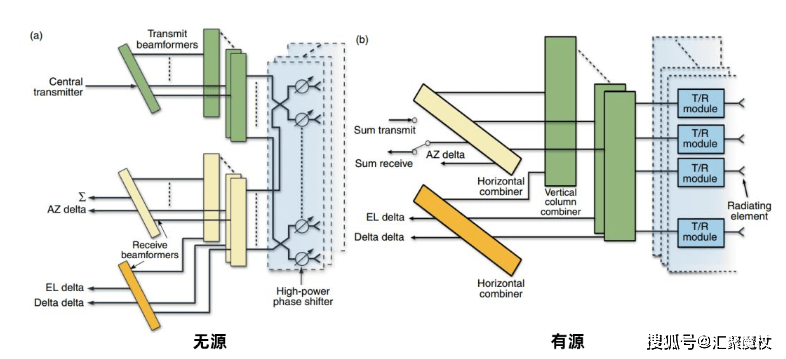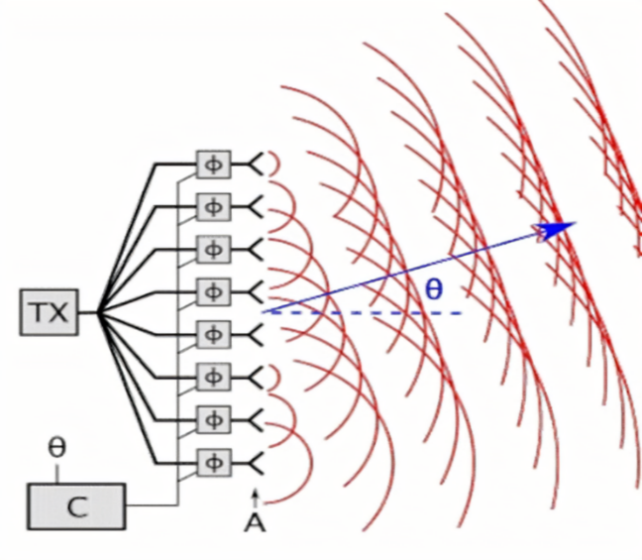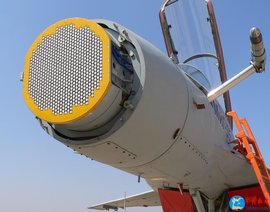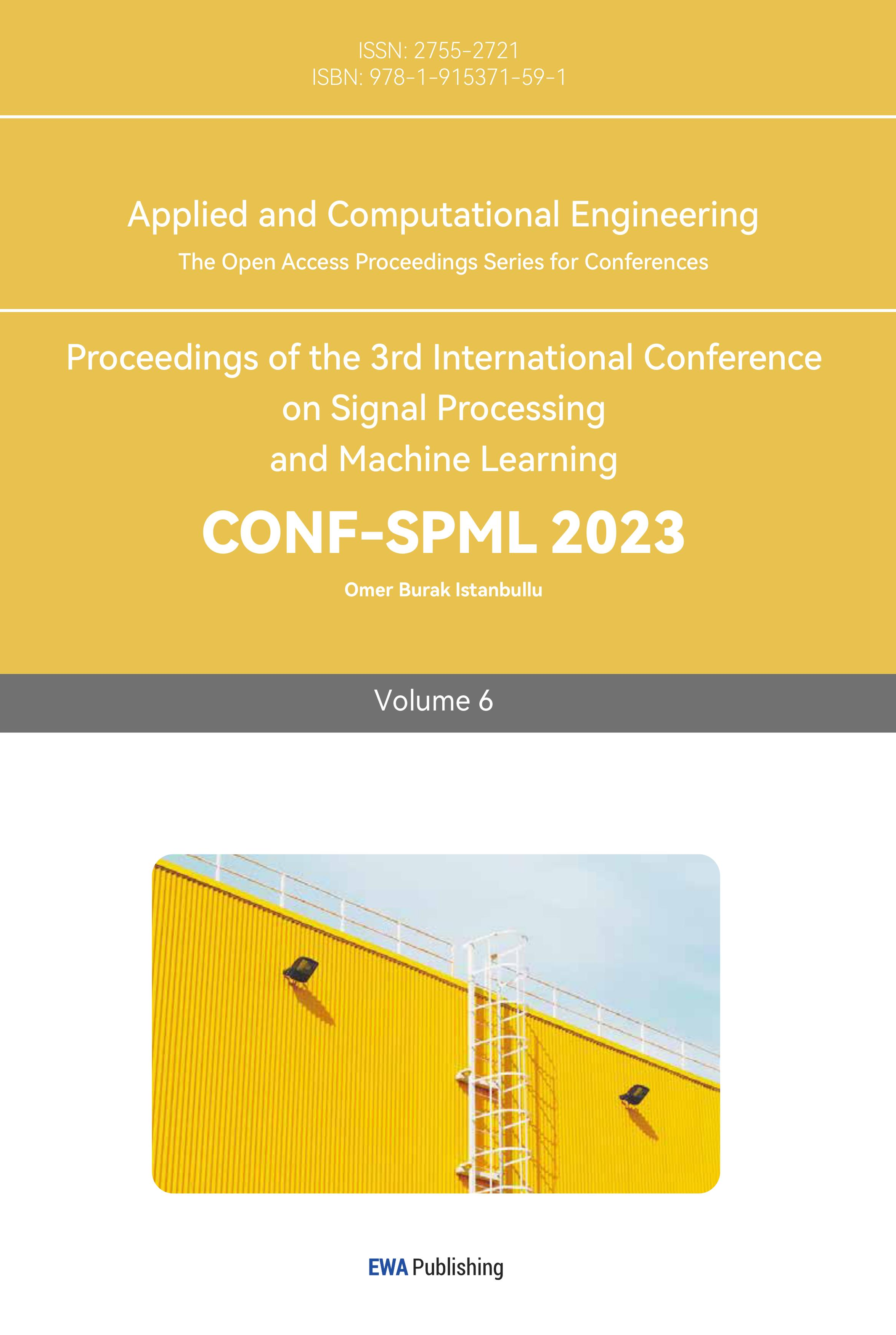1. Introduction
Phased array technology first appeared in the late 1930s, and shipborne phased array radar appeared in the mid-1950s. Compared to the traditional radar, traditional radar detects the target through the rotation of the signal transmitter and receiver. It only has one beam, it is difficult to deal with multiple targets [1]. However, the phased array radar manages to control the irradiation azimuth of the electromagnetic wave to scan targets. Objects that are in front of the radar array can be observed in real time and the response speed is faster than that of tradition radar. In addition, the phased array radar can detect complex targets due to form multiple beams. In recent years, the application of phased array radar in the sky, space and sea has become more and more extensive. It may have more advanced applications in the future.
2. The mechanism of Phased Array Radar Technology
2.1. Active and passive phased array radar
There is not too much difference between passive and active phased array radar in appearance. The biggest difference between these is how much the strength of the transmitted electromagnetic wave signal is amplified and how much the received echo signal is amplified [2]. As shown in figure 1, each small unit of passive phased array radar does not have an independent amplifier. The electromagnetic wave signal strength of each small unit is uniformly amplified by a unified amplifier and then distributed to the antenna of the small unit. The entire work of each small unit used to be performed passively. However, in the active phased array radar, each small unit has an independent amplifier and the electromagnetic wave signal received by each small unit is a weak signal. The antenna of the small unit amplifies the electromagnetic wave signal to the required degree according to its requirement. In this way, each small unit can achieve more functions [3]. In addition to the traditional search and tracking, it can also carry out electronic countermeasures and long-distance communication.

Figure 1. The different working principle of passive and active phased array radar
(a is passive; b is active) [4].
There is no doubt that the cost of active phased array radar is more expensive, and it should integrate thousands of transmitting and receiving components within a square inch, and a cooling system of the same level of complexity is also required. However, each small unit can have huge advantages in bandwidth, signal processing and redundancy. It seems to be a technological leap, which can improve the accuracy of radio waves and achieve more functions.
2.2. Working principle of phased array radar
Phased array radar achieves angular scanning by shifting the voltage phase in the antenna element without rotating the mechanical antenna. This phase shift can only be produced at a very high voltages, typically several thousand volts [5]. Therefore, this required considerable size and weight for the device.
Phased array radar are phased array antenna radar and electronically scanned radars. If the antenna adopts an electronic way to realize the antenna beam steering or scanning in space, this kind of antenna is called an electronically scanned antenna or an electronically scanned array antenna. Electronically scanned antennas can be classified into phase-scanned and frequency-scanned antennas according to the beam scanning ways .
The phased array antenna is formed by arranging multiple antenna elements and signal power distribution or summation network components in a certain order on a plane or curved surface. If the phased array antenna is distributed on a plane, it is called a planar phased array antenna. If it is distributed on a curved surface, it is called a curved phased array antenna. It can be clearly seen in figure 2, a phase shifter is provided on each antenna and the phase shifter is used to change the phase relationship between the signals of the antenna elements. The variation of signal amplitude between antenna elements is achieved by unequal power distribution or summing networks and attenuators. Under the control of the beam steering computer, the phase and amplitude relationship between the antenna elements can be changed, so that the direction and shape pf the antenna beam can be changed [6].

Figure 2. The working principle of passive phased array radar [7].
2.3. Advantages and disadvantages
In general, the advantages of phased array radar obviously outweigh its disadvantages. For traditional radar, phased array radar is its superior substitute in all aspects.
The beam direction is flexible, which can realize fast scanning without inertia, and it has a high data rate.
A radar can form multiple independent beams at the same time to realize the functions of search, identification, tracking, guidance and passive detection.
Phased array radar has a large target capacity. Hundreds of targets can be monitored and tracked simultaneously in the airspace.
Strong adaptability to complex target environment.
Good anti-interference performance. The reliability of all solid-state phased array radar is high, and it can work normally even if a few components fail [8].
However, phased array radar also has disadvantages, which are manifested in two aspects.
Phased array radar equipment is complex, and the beam scanning range is limited. The maximum scanning angle is 90 degrees to 120 degrees. When omni-directional monitoring is required, 3-4 antenna arrays need to be configured.
Phased array radar is very expensive. The cost of ordinary radar is tens of thousands to millions of dollars, while the cost of phased array radar can reach hundreds of millions of dollars. The price of aegis radar in the United States is even higher, and the cost of supporting radar is as high as US 200 million. This is mainly related to the material development trend of the core components of active phased array radar. The core component of the phased array radar is the T/R component, and its cost accounts for about 60% of the entire radar cost [9]. After entering the 21st century, the main material of this part is gradually changing from gallium arsenide to gallium nitride to improve the power of radar. As a third-generation semiconductor material, gallium nitride has become a highly discussed material due to its superior performance in high-power, high-speed optoelectronic components. Due to the higher breakdown voltage, the current and corresponding energy loss can be reduced by greatly increasing the voltage. After the core component T/R component of the phased array radar uses gallium nitride, the energy utilization rate and power will be greatly improved. In this way, the performance of radars using gallium nitride can be improved, and the heat dissipation problem can be relatively weakened.
3. Applications and Prospect
3.1. Stealth aircraft
Stealth aircraft and modern air warfare need phased array radar. As shown in figure 3, stealth aircraft equipped with phased array radar (PESA or AESA) is almost the only option. So far, there is no stealth aircraft using mechanical scanning radar [10]. Low probability of interception (LPI) and low observation characteristics (LO) are the key to the stealth aircraft and the successful completion of combat tasks [11]. In the current extremely severe electronic jamming environment, the probability of electromagnetic waves radiated by airborne radar being intercepted by the enemy. It is an important performance index. When attacking aircrafts or single aircrafts covered by special electronic jamming aircraft, strong electromagnetic interference will make the traditional radar unable to work normally. The amplitude and phase of the aperture field of the AESA antenna can be controlled, which can make the zero value of the antenna sidelobe point to the enemy jamming source. Therefore, it cannot implement effective jamming. Through digital beam forming (DBF) technology, the main beam can be separated into two beams, so that its zero value is aimed at the enemy jamming source. If several jamming sources are located in the radar side lobe direction, zero value can also be formed in this direction, so that the enemy cannot receive the radar signal. Effective jamming cannot be implemented. The adaptive beamforming capability of AESA is an important factor for airborne radar to maintain its combat capability in complex electromagnetic environment.

Figure 3. The phased array radar in aircraft.
3.2. American patriot AN/MPQ-53 multi-functional phased array radar
American patriot AN/MPQ-53 multi-functional phased array radar is mainly composed of radar and control vehicle interface device, controller mixing, transmitter mixing, RF exciter and receiver mixing. It was mounted on a tractor and the US military put it under the car for a parade in the suburbs. If it is in operation, it will be specified at 67.5 degrees to confirm the enemy’s range of motion. Using flexible variable beam to track targets, 90125 target can be monitored at most within the 120 degrees sector, 8 targets can be tracked, instructions can be received from 5 missiles and 3 missiles can be launched.
3.3. Civil Field of Phased Array Radar
One of the fastest growing is the field of meteorological detection. Compared with traditional weather radar, the function of phased array weather radar is a dimensionality reduction blow. For example, Beijing Daxing Airport uses the C-band all-digital active phased array weather radar. Whereas conventional weather radar takes 6 minutes to complete an 11-layer volume scan, this radar takes only 1 minute to complete. At the same time, the radar adopts distributed transmission and reception technology, and the reliability is increased from 600 hours of conventional radar to more than 3,000 hours. In addition, the radar has comprehensively improved the ground clutter suppression ability, anti-jamming ability and automatic detection ability, which can detect thunderstorms, strong winds, downbursts, wind shear and other dangerous weather affecting aviation safety faster and more accurately, which can play a huge role in air traffic control meteorological dangerous weather monitoring.
4. Future development prospects
4.1. Derivative new detection system
In order to improve the distance, accuracy and resolution of the radar monitoring network and the ability of electronic environment, it is necessary to constantly analyze the new concepts and theories of radar detection and submit quantum imaging radar. New radar system structure should be considered. In order to get rid of the excessive limitations of traditional imaging radars on target movement or scanning platform collision and the current need to adopt relatively expensive and simple imaging technology.
4.2. Expanding to higher frequency band
The high-frequency band has the advantage of high beam image resolution, strong anti-stealth ability, strong anti-interference ability, and strong high-frequency band penetration ability. This high-frequency band makes the voltage modulated array radar rapidly expand to terahertz and laser bands. (1) Multi-function integration: integration of target indication and fire control. (2) Further improve the anti-jamming ability: use a variety of anti-jamming measures and LPI waveform to improve the survivability of the radar. (3) Self simulation phase-shifting beamforming system to subarray DBF technology system.
4.3. Quantum radar
The most promising radar technology at present is quantum radar, which can see the aircraft and ships that have adopted stealth technology [12]. In 2012, the research team of the Institute of Optics of the University of Rochester successfully developed an anti-jamming quantum radar, which uses photons to image the target. Since any object will change its quantum properties after receiving a photon signal, this is the case. This type of radar can detect stealth aircraft and is almost undisturbedly. The MIT researchers believe this is the first imaging system developed using quantum mechanics, and the results are impressive and immune to any radar-jamming measures. However, the equipment needed for quantum detection technology can be developed in laboratories around the world, but not in the military.
5. Conclusion
Phased array radar, as the upper replacement of traditional radar. It is far superior to radar in response speed and function. Because there are many secrets about the technical details of phased array radar at present. This report focuses only on the fundamentals and basic operation of phased array radars. For different types of phased array radar, its internal structure will be different. Nowadays, phased array radar is widely used in the military field and is the most widely used in ships and airplanes. Its main function is to detect the position of the enemy and to predict and prevent attack. Its ability to detect multiple targets at the same time plays a very important role in the actual combat. Many countries, such as the United States, Germany and Russia, have far-reaching research on phased array radar. However, the current high cost of phased array radar is the main problem that limits its application in other civil fields. In the future, optimizing the structure and performance of phased array radar will enable it to become more powerful in function, although the cost may also be reduced. Combined with the current technical situation of phased array radar, the future radar may not be able to effectively reduce energy consumption, but high energy consumption can significantly improve the response speed of the radar, which can achieve the meter level for positioning and the target. To locate hundreds of targets at the same time.
References
[1]. A. Aprile, A. Mauri, D. Meledandri, T. Macri Pellizzeri and N. Pendeggia (2008). GRIFO Radar: Advances and developments in high-resolution modes for an expert avionic radar for fighters. 2008 IEEE Radar Conference, 1-5.
[2]. R. Bil and W. Holpp (2016). Modern phased array radar systems in Germany. 2016 IEEE International Symposium on Phased Array Systems and Technology (PAST), 1-7.
[3]. K. Kim et al (2018). Development of planar active phased array antenna for detecting and tracking radar. 2018 IEEE Radar Conference (RadarConf18), 100-103.
[4]. IEE Colloquium on 'Active and Passive Components for Phased Array Systems' (1992), IEE Colloquium on Active and Passive Components for Phased Array Systems, pp. 0_1-.
[5]. Zhang Rongzhi and Yang Kaizhong (2020). 3 – Space object detection technology. 2020 Spacecraft Collision Avoidance Technology, 35-72.
[6]. Tao Li, Erwin Hoi Wing Chan, Xudong Wang, Xinhuan Feng, Bai-Ou Guan, Jianping Yao (2018). Broadband Photonic Microwave Signal Processor With Frequency Up/Down Conversion and Phase Shifting Capability. IEEE Photonics Journal, 10(1), 1-12.
[7]. S. Rathod, A. Raut, A. Goel, K. Sreenivasulu, K. S. Beenamole and K. P. Ray (2019), Novel FPGA based T/R Module Controller for Active Phased Array Radar, 2019 IEEE International Symposium on Phased Array System & Technology (PAST), pp. 1-5
[8]. W. Holpp (2008). E-Scan Radar for Eurofighter-Technology Benefits and Achievements. NATO MSS.
[9]. M. Pirkl and W. Holpp (2013). From Research to Application: How Phased Array Radar Conquered the Real World. Proc. International Radar Symposium 2013.
[10]. S. Rathod, A. Raut, A. Goel, K. Sreenivasulu, K. S. Beenamole and K. P. Ray (2019). Novel FPGA based T/R Module Controller for Active Phased Array Radar. 2019 IEEE International Symposium on Phased Array System & Technology (PAST), 1-5.
[11]. Zhang Rongzhi and Yang Kaizhong (2020). 3 – Space object detection technology. 2020 Spacecraft Collision Avoidance Technology, 35-72.
[12]. Tao Li, Erwin Hoi Wing Chan, Xudong Wang, Xinhuan Feng, Bai-Ou Guan, Jianping Yao (2018). Broadband Photonic Microwave Signal Processor With Frequency Up/Down Conversion and Phase Shifting Capability. IEEE Photonics Journal, 10(1), 1-12.
Cite this article
Xie,J. (2023). The research on phased array radar technology and its applications. Applied and Computational Engineering,6,385-390.
Data availability
The datasets used and/or analyzed during the current study will be available from the authors upon reasonable request.
Disclaimer/Publisher's Note
The statements, opinions and data contained in all publications are solely those of the individual author(s) and contributor(s) and not of EWA Publishing and/or the editor(s). EWA Publishing and/or the editor(s) disclaim responsibility for any injury to people or property resulting from any ideas, methods, instructions or products referred to in the content.
About volume
Volume title: Proceedings of the 3rd International Conference on Signal Processing and Machine Learning
© 2024 by the author(s). Licensee EWA Publishing, Oxford, UK. This article is an open access article distributed under the terms and
conditions of the Creative Commons Attribution (CC BY) license. Authors who
publish this series agree to the following terms:
1. Authors retain copyright and grant the series right of first publication with the work simultaneously licensed under a Creative Commons
Attribution License that allows others to share the work with an acknowledgment of the work's authorship and initial publication in this
series.
2. Authors are able to enter into separate, additional contractual arrangements for the non-exclusive distribution of the series's published
version of the work (e.g., post it to an institutional repository or publish it in a book), with an acknowledgment of its initial
publication in this series.
3. Authors are permitted and encouraged to post their work online (e.g., in institutional repositories or on their website) prior to and
during the submission process, as it can lead to productive exchanges, as well as earlier and greater citation of published work (See
Open access policy for details).
References
[1]. A. Aprile, A. Mauri, D. Meledandri, T. Macri Pellizzeri and N. Pendeggia (2008). GRIFO Radar: Advances and developments in high-resolution modes for an expert avionic radar for fighters. 2008 IEEE Radar Conference, 1-5.
[2]. R. Bil and W. Holpp (2016). Modern phased array radar systems in Germany. 2016 IEEE International Symposium on Phased Array Systems and Technology (PAST), 1-7.
[3]. K. Kim et al (2018). Development of planar active phased array antenna for detecting and tracking radar. 2018 IEEE Radar Conference (RadarConf18), 100-103.
[4]. IEE Colloquium on 'Active and Passive Components for Phased Array Systems' (1992), IEE Colloquium on Active and Passive Components for Phased Array Systems, pp. 0_1-.
[5]. Zhang Rongzhi and Yang Kaizhong (2020). 3 – Space object detection technology. 2020 Spacecraft Collision Avoidance Technology, 35-72.
[6]. Tao Li, Erwin Hoi Wing Chan, Xudong Wang, Xinhuan Feng, Bai-Ou Guan, Jianping Yao (2018). Broadband Photonic Microwave Signal Processor With Frequency Up/Down Conversion and Phase Shifting Capability. IEEE Photonics Journal, 10(1), 1-12.
[7]. S. Rathod, A. Raut, A. Goel, K. Sreenivasulu, K. S. Beenamole and K. P. Ray (2019), Novel FPGA based T/R Module Controller for Active Phased Array Radar, 2019 IEEE International Symposium on Phased Array System & Technology (PAST), pp. 1-5
[8]. W. Holpp (2008). E-Scan Radar for Eurofighter-Technology Benefits and Achievements. NATO MSS.
[9]. M. Pirkl and W. Holpp (2013). From Research to Application: How Phased Array Radar Conquered the Real World. Proc. International Radar Symposium 2013.
[10]. S. Rathod, A. Raut, A. Goel, K. Sreenivasulu, K. S. Beenamole and K. P. Ray (2019). Novel FPGA based T/R Module Controller for Active Phased Array Radar. 2019 IEEE International Symposium on Phased Array System & Technology (PAST), 1-5.
[11]. Zhang Rongzhi and Yang Kaizhong (2020). 3 – Space object detection technology. 2020 Spacecraft Collision Avoidance Technology, 35-72.
[12]. Tao Li, Erwin Hoi Wing Chan, Xudong Wang, Xinhuan Feng, Bai-Ou Guan, Jianping Yao (2018). Broadband Photonic Microwave Signal Processor With Frequency Up/Down Conversion and Phase Shifting Capability. IEEE Photonics Journal, 10(1), 1-12.









